 (72Kb jpeg)
(72Kb jpeg) (64Kb jpeg)
(64Kb jpeg)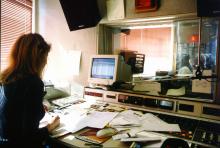 (77Kb jpeg)
(77Kb jpeg)On the 24th of September the Wellington Photographic Society embarked
on an ambitious project, to chronicle the various facets of life going on
in Wellington over a 24hr period. It was a daunting project requiring a
furious level of organisation, supporters to keep everything running and
judges to pick the final exhibition images as well a large body of
photographers to go out and do the shooting. The end result has been
collected online here :-
http://photosoc.wellington.net.nz/24hrs/
And is worth rummaging through, some absolutely stunning images have been
collected.
This page is my reflections on the event, from the perspective of a participating photographer.
It being my first big organised photographic event I wasn't entirely sure what to expect. Indeed I spent a certain amount of time dithering wondering whether my photographic skills were up to the task at all. In the end they weren't but not for the reasons I was worrying about. With hindsight and looking over the images I can see where my lacks lay was in the selection of images I put forward. I have captured at least two images from the event that I am very pleased with and a range of others that I am happy with but for various reasons these weren't the images I put forward.
But I am getting ahead of myself.
The process for me began with the build up to it in the form of the various meetings, workshops and the like held by the club before the main day. These were part inspirational and part practical as they gave us experience and ideas for the event itself. The most useful ones being the talks where we went out and did something - using either what had just been talked about or trying something and then being given some analysis of the results. Unfortunately, this was to become something of a trend, some of the workshops were sprung on us a little precipatedly making for some undue rushing around.
Now I realise the aim of the experiment was to recreate the kind of working conditions that press photographers often get into. Namely a lack of time. But I sometimes wonder if the people organising these things forget that there are passions and interests away from photography that curtail our time. For a hobbiest springing things on them last minute is a little rough. Take the yachting for instance, I don't own serious wet weather gear because - like most sensible people - I get out of the rain and if not than a good coat will suffice. I don't own the plastic leggings and waterproof gear that is really needed for a day on the harbour.
Therefore giving us about a days warning on the assignments chosen was a bit vexing because it left pretty much no time to track down or arrange for the proper accoutrements. Still, for most people this wasn't a hassle because their assignments tended to be in drier environments where camera and person were less likely to be soaked without the right equipment. And so it was for the first assignment I was given - to photograph the studio of a radio station.
Now it has been my observation that given a camera and a certain amount of charm one can convince people to do surprising things in front of the camera. Especially the somewhat more extroverted people out there. And, well, radio announcers by their nature tend to be fairly extroverted people. The net result is someone who is quite fun to take shots of as they are very happy to be in front of the camera. Nothing is worse than trying to take a portrait shot of someone who doesn't want to be in the shot - at least for a cheerful picture anyways. Occasionally a look of anger or resentment can make for a strong shot but I prefer to avoid those and respect the wishes of the person being photographed.
So about an hour on Saturday morning I was permitted access to the radio station's behind the scenes and got to see exactly how they work. Now one thing to remember when doing this kind of shot is that generally you are looking for a spontaneous shot and doing your work handheld - this means that film speed and lighting become critical to avoid the dread handshake disease. I thought with the use of ISO400 film that this wouldn't be an issue. Unfortunately I was wrong.
Y'see even while the day was nice and bright the people working inside tend not to like overly bright work environments, so the windows were shuttered. And being the unconfident type I am I didn't actually ask to open them up and get some better light. This is lesson one to learn, if you aren't happy with the shooting conditions at least ask to change them. People generally are happy to help, especially if they want the shots afterward. The net result was that I spent a lot of my time keeping my focal length down around the 35mm mark which gave me very little framing ability to work with. I would have tried some flash were it not for the fact that my on camera flash, which is the only flash I have, is obstructed by the lenses I use so has an unsightly semicircular shadow cast when I use it.
Lesson two, when shooting carry a flash to help with low light situations. Especially one you can place or hold slightly away from your camera to avoid red-eye effects as well. Of course a good flash is expensive which leads me to a meta grumble about photographers in general - many of them when talking forget that photography isn't necessarily your primary hobby and thus the somewhat pricey nature of equipment is a barrier to getting all the various gadgets. I'd really like to get my hands on a light meter and a flash so that I can start doing more portrait work and have tighter control over the image. But this will have to wait till I can spare the cash.
Anyway the net result was a set of, in my opinion, fairly uninspiring
shots. Moderately competent but not the kind of shot I hold up as one of
my best efforts. Here are the ones I picked as the best versions for
entry into the competition.
 (72Kb jpeg)
(72Kb jpeg)
 (64Kb jpeg)
(64Kb jpeg)
 (77Kb jpeg)
(77Kb jpeg)
As you can see too much extraneous detail has been included and the end result is very cluttered and flat in appearance. Definitely room for improvement. Ideally what I wanted to do is close in on the defining characteristics of the job - the mic and the announcer's face. Widening the shot slightly I believe I could have easily got some fairly dynamic shots out of it by bringing in his hands - which he was quite expressive with at times.
So at some stage I shall have to attempt this again and see what I can do when I have the right gear with me and now that I have some experience to draw on. After doing the radio interview about the 24hrs project, which was the stations pay off for letting me loose in their studio, I then had to dash to get to my second and final assignment - The Royal Port Nicholson Yacht Club opening day race.
Now this is where the event really began to take off for me. Normally I'd never get a chance to get up close with the yachts and actually go out with them for the races. Here they were doing quite a lot to make that not just easy to do, but fun as well. Being a minor, very minor, sailing nut I had an absolute blast with this. First off they allow me to go out on the 'Te Aro' rescue boat for the opening of the race. This allowed me to be in among the yachts as they tacked and jockied for opening position. It isn't till you are on a small boat in the middle of the harbour with one of the yachts literally hissing past you at speed that you realise how big these boats are. From the TV images you can get a false impression that the average yacht is a fairly small craft.
Nope.
And being in the middle of these craft, looking up a little to see the crew is just amazing. I went into what I call 'snapping frenzy' and had exhausted a fresh 36 roll of film in fairly short order. I was sufficiently out of it that when the camera grumbled about the lack of film it took me a little while to work out what was going on. Of course I was worried about salt water getting into the camera - salty water and delicate camera internal do not mix well - so I claim being somewhat distracted by that as well. Indeed when it initially stopped shooting that was precisely what I thought had happened. Again a little notice of the event would have given me a chance to track down some method of water proofing the camera - even if only taping a plastic bag around it to keep the majority of the spray off it.
Still the camera and I survived the trip on the 'Te Aro' and I got
what I consider to be my best shot of photoshoot from it. This one :-
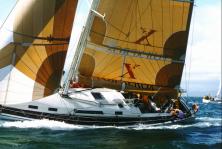 (82Kb jpeg)
(82Kb jpeg)
Just magic. I also tried a bunch of other shots that, for various
reasons, didn't really work out. I tried to take shots of the HMS
'Wellington', on it's last trip before being decomissioned, but the Navy
grey colour did precisely what it is intended to - the ship faded into
the background and didn't really stand out. I thought having a shot of
the yacht race, with the HMS 'Wellington' behind and all that in front of
the downtown Wellington city front would have made for a good shot. But
the results were somewhat dull - mostly because the action in the shot
was too small I believe with no easily distinguishable features or clear
point of focus.
And many of the other shots that came close suffered from that other nasty problem with shooting on boats - swell. The boats were rolling and rocking in the water sufficiently that not only do you have to concentrate on the timing for the subject in terms of it's motion but you must correct for the movement of the boat you are on as well. Even with me shoving the camera into almost completely automatic mode it still was a real challenge getting the timing right. A certain amount of luck featured therefore in the shots that did work.
But anyway, after the exhiliration of being on the 'Te Aro' we headed back into the yacht club where I reloaded the camera with another roll of film and was able to go out on one of the launches monitoring the racing and providing a front seat view for the passengers on the launch. Now never having been out onto the harbour on anything but a calm day in a small boat I made a somewhat silly goof - I decided to try sitting on the top deck of the launch. Sadly it wasn't a calm day out there, unsurprising really given that one needs wind to race sailing yachts and while the top deck was great initially as soon as we moved out past the breakwater I discovered why no one else had joined me for this vantage point...
The first wave came over and I managed to cover the camera in time and
I thought, perhaps that is a freak wave and they won't come too often.
When, thirty seconds later, another wave came crashing through and we
hadn't even really hit the rough water yet I decided that for both my
camera & my sake that a hasty retreat to drier areas was well advised.
As it was the notebook I had been using got soaked and I think I whisked
the camera back inside just in the nick of time. Even shooting from the
back of the boat, it was hard to dodge the waves and spray. This
curtailed my ability to select shots somewhat and as a result I only
got the aftermath of this :-
 (59Kb jpeg)
(59Kb jpeg)
What was really annoying was that I could see it coming and if my camera
was water proof I would have stood a good chance of capturing the event
as it happened.
Instead I had to make do with shots like these. It is a hard sacrifice
to make but still, we deal with what we must.
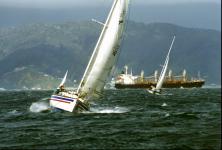 (71Kb jpeg)
(71Kb jpeg)
 (70Kb jpeg)
(70Kb jpeg)
So all in all I arrived back at the berth knowing that I had something in
the camera but not entirely sure what. Now I had to drop the films off to
the staging post to be express developed and then I could come back to do
the selection process.
Now here I have two minor grumbles. The first is parking - you put your command centre smack dab in the middle of town on a busy Friday night/Saturday shopping period and then don't provide any parks for quick drop offs of film. Needless to say I was singularly unimpressed with this and after three quarters of an hour circling looking for a park I finally found one. It was getting sufficiently close to the deadline that I was wondering if I would get my film in on time. Secondly here is another occasion when a surprise fee snuck up on me - to get the film developed to negative stage was built into the cost of entering the shoot. But to get prints would cost extra. Now I have no problem with it costing extra but I do have a problem with not knowing about this a few weeks ahead to allow me to budget for it. Three films, at $15 per film, is an extra $45 over the $50 you already pay - and if you got a shot selected to be in the final display then you paid for the enlarged reprint as well. This all adds up to a serious amount of extra cash that wasn't that clearly signaled about before the shoot began.
Again perhaps the professionals, having done photoshoots before,
expect this but for a hobbiest that extra money came at a time when I
couldn't really afford it. (Payday was just after the photoshoot) So I
ended up having to choose my entries from the negatives alone. Now an
inverting display unit was available but the resolution isn't the best
and time pressures with other people wanting to use the unit meant you
didn't really have time to ponder your choice of images. The net result
is that I think I horribly mucked up my choice of images. Combined with
the radio station shots above here are the shots I selected. I think you
will agree they are pretty blah.
 (59Kb jpeg)
(59Kb jpeg)
 (82Kb jpeg)
(82Kb jpeg)
I made the best of the radio shoot shots but the yacht shots picked
were uninspiring. I made a mistake that is the next lesson from the
photoshoot - trust your instinct on what is a good shot. I listened to
one of the team leaders who advised us to make sure the shots had a
Wellington flavour to them. Something that uniquely identified it as
being in Wellington. When you look at the final exhibition few of the
shots have that factor at all, instead the judges picked on the strength
of the shot and it looks like they went for a wide variety of subjects -
trying to encapsulate the whole of Wellington life into the selected
photos. So the real advice is, do the assignments given and then go with
what you consider to be the strong shot and largely ignore the advice of
anyone who isn't a judge. So shots like these I might have used, rather
than discarding out of hand purely because they weren't 'Wellington'
enough :-
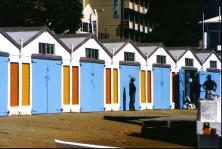 (80Kb jpeg)
(80Kb jpeg)
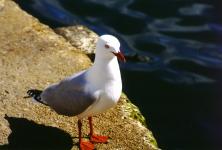 (59Kb jpeg)
(59Kb jpeg)
After all if you are interested in photography in the first place you
must already have an eye for what looks striking. So trust that instinct
and pick your stronger shots. After all if all your shots have been taken
on the photoshoot then they will tend to be on subject anyways. Anyways
once I had selected the images time was then spent preparing them for
scanning and waiting for the judging process. As it turned out none of my
images made it into the final selection. I suspect with a slightly better
image choice on my part I might have made it.
But overall experience was worth it. As a validation of my ability to go out and get shots that were at least workable, and some that are stunning. And as a validation that my instincts about image selection are to be trusted rather than ignored. These are the primary lessons learned from the photoshoot and even with the aggrivation involved it was well worth it. I'd recommend anyone interested in photography to have a go - photojournalism is heavily biased towards the less technical aspects and the more creative ones by it's nature. And as such the more junior photographers, like me, can shine as the camera automatics handle the technical aspects you and concentrate on composition and timing.